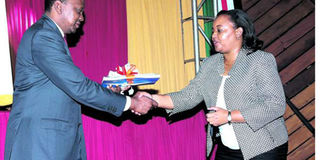Uhuru scores big on gender rule

President Uhuru Kenyatta presents a copy of the Public Sector Remuneration and Benefits Policy document to the Cabinet Secretary for Devolution and Planning, Anne Waiguru, during it's official launch at K.I.C.C, Nairobi. President Kenyatta has beaten the gender legal condition in the latest list of parastatal appointments. FILE PHOTO | NATION MEDIA GROUP
What you need to know:
- Out of 345 officials proposed to join various parastatal boards, 114 are female. This represents 33 per cent of the entire group.
- They include, plant health specialist Rose Njiru, mathematician Patricia Gathia, Beatrice Sabana, Margaret Mwakima, Rahab Nyaga, Anne Wangari Thairu-Muigai, Carol Karugu, Joy Kiano and Bancy Mbura.
- Though no county has taken more than six per cent of the appointments, most boards have officials from Nakuru, Kiambu, Uasin Gishu, Meru and Nairobi counties.
President Uhuru Kenyatta has beaten the gender legal condition in the latest list of parastatal appointments.
Out of 345 officials proposed to join various parastatal boards, 114 are female. This represents 33 per cent of the entire group.
And even though this is only the bare minimum, the President could rest easy because the Constitution requires at least a third of elected or appointed officials be from a different gender.
Among the women proposed are 11 PhD holders.
They include plant health specialist Rose Njiru, mathematician Patricia Gathia, Beatrice Sabana, Margaret Mwakima, Rahab Nyaga, Anne Wangari Thairu-Muigai, Carol Karugu, Joy Kiano and Bancy Mbura.
This list also contains young scholars Eunice Nyambura Mwangi (36) and Carol Wanjiru Karugu (37), both holding PhDs.
WELL-EDUCATED
Educationist Jane Moronge, who is set to join the Post Bank board, is pursuing a doctorate in Education.
There are 45 PhD holders on the list, which is three times the number of diploma holders.
Although most on the list have not indicated their level of education, a majority of the appointees have either first degrees or postgraduate education.
But even with the gender accolades, the President will still be accused of favouring particular regions.
Though no county has taken more than six per cent of the appointments, most boards have officials from Nakuru, Kiambu, Uasin Gishu, Meru and Nairobi counties.
Nairobi has 26 officials, Nakuru 18, Uasin Gishu 15, Kiambu 19 and Meru 16.
Lamu and Nyamira have one each. Even more curious, 33 officials have not indicated their home county.
The government has in the past said that this results from some officials settling in other counties because of marriage or migration.
COUNTY NOT INDICATED
Because they still feel attached to their native areas, most do not indicate their definite “home county”.
Even if the analysis is based on former provinces, the Rift Valley takes a third of the appointments, but former North Eastern Province has been allocated just four per cent of the slots.
Nairobi has 26 slots, Western 25, Central 56, Eastern 57, Coast 29 and Nyanza 33.
However, one State House official with knowledge on appointments told the Nation Sunday that the regional distribution followed the population percentages of former provinces as per the 2009 census.
“There were about 2.3 million in North Eastern Province, which is about six per cent of the national population of 38 million. Rift Valley still had about a third of the national population.
“These appointments have followed the same design and it is envisioned that any increase in population would follow the pattern,” the official explained.
TRIMMING OF NUMBERS
The list, which was publicised on Saturday, is the culmination of lengthy deliberations within the government as the Jubilee administration tries to weed out numerous appointees of the Kibaki-Odinga government.
It is the brainchild of the 2013 recommendations from the Presidential Task Force on Parastatal Reforms.
The team, then co-chaired by former Mandera Central MP Abdikadir Mohamed and CBA boss Isaac Awuondo, recommended trimming the number of those corporates from 262 to 187 through mergers, dissolutions, reclassification or transfer of functions.




